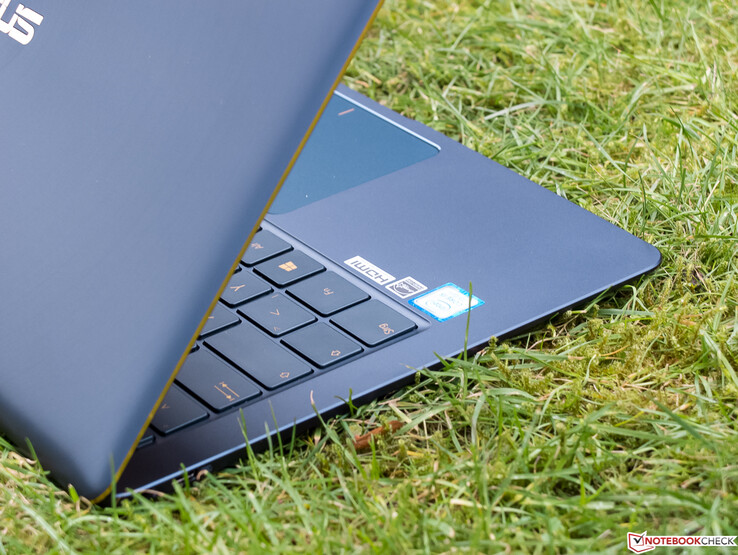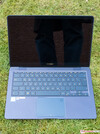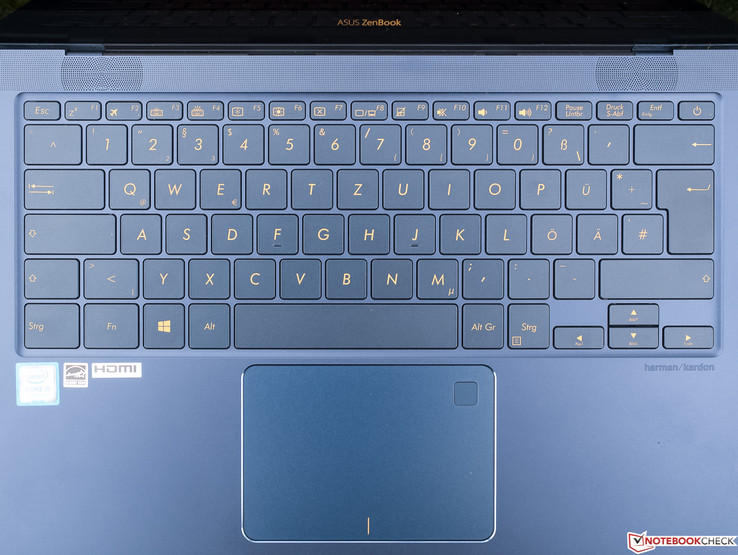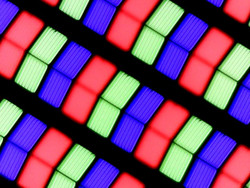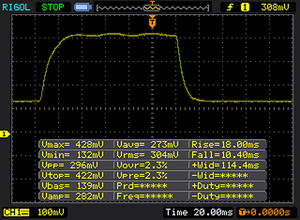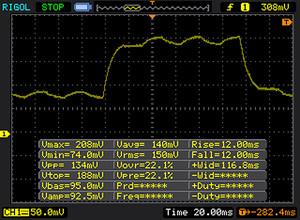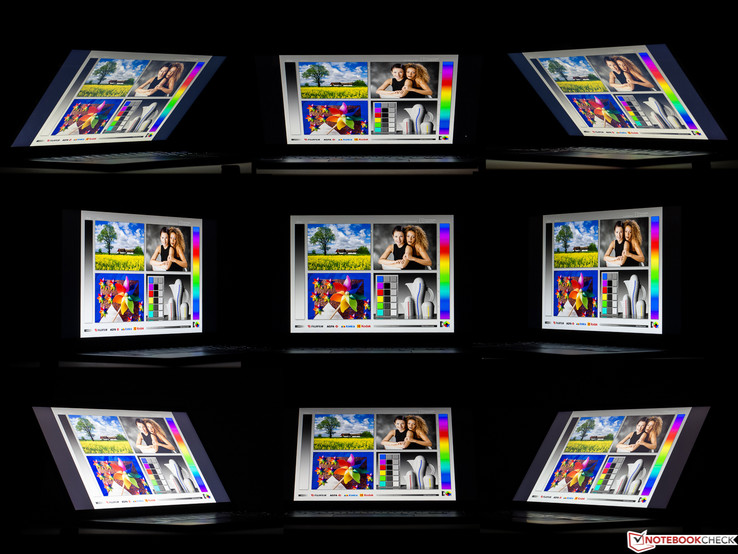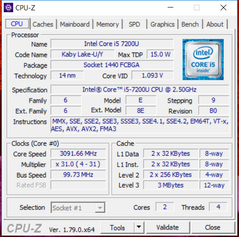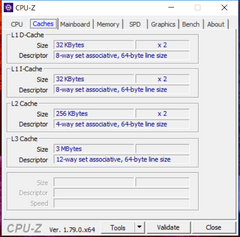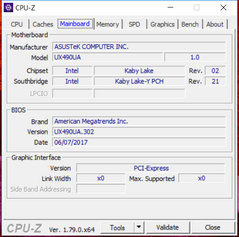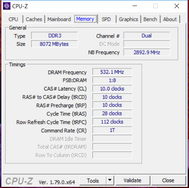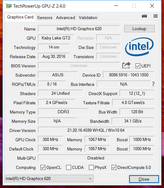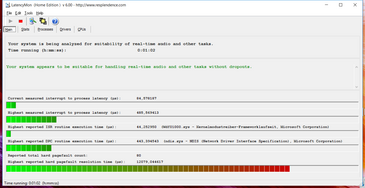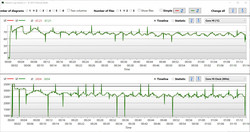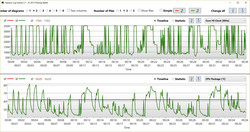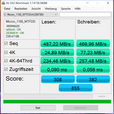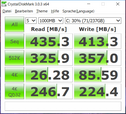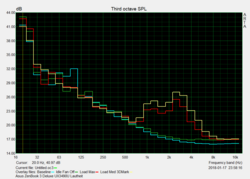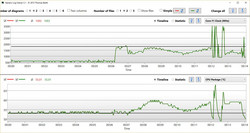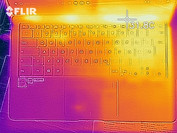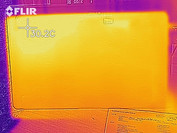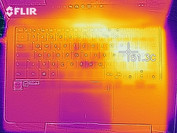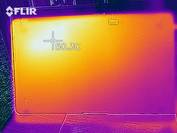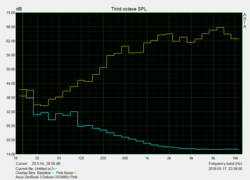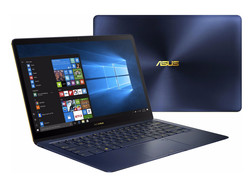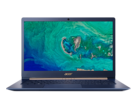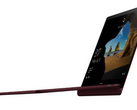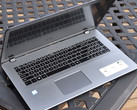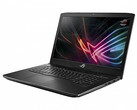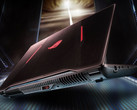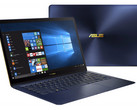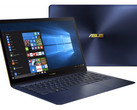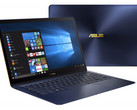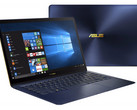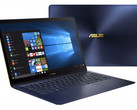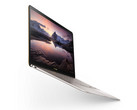Asus ZenBook 3 Deluxe UX490UA (i5-7200U, 256 GB SSD) Subnotebook Review

Asus’ latest ZenBook 3 Deluxe is a classy particularly compact and thin portable office notebook, and successor to the 2016 ZenBook 3. As such, it is also a direct competitor to Apple’s MacBook Air. The Taiwanese manufacturer flaunts its latest notebook on its website and certainly isn’t shy of praises of the highest degree. Among others, Asus claims a “breathtakingly exquisite design” and refers to the ZenBook 3 Deluxe as “masterpiece of craftsmanship” and “the coolest of cool”. The so-called NanoEdge display is of particular interest - thanks to its amazingly narrow bezels the engineers have been able to fit a 14-inch panel into what seems to be a 13-inch display lid.
Our review unit was equipped with Intel’s Core i5-7200U and 8 GB of RAM. Additional SKUs with faster processors (Core i7-7500U) and up to 16 GB of RAM are available as well. Storage options start with a 256 GB SATA III SSD (which our review unit was equipped with) and go up to 512 GB or even 1 TB large NVMe/PCIe SSDs. The Windows 10 Home edition our test unit came with can be replaced with Windows 10 Professional if so desired. Potential buyers get to choose from two different color options: “Royal Blue” and “Quartz Gray”. Dedicated GPUs are not available in this series. At the time of writing, two SKUs were available for sale in the US: an i7-7500U model for around $1,600 and an i7-8550U model starting at $1,500.
Given its heritage and specifications, the ZenBook 3 Deluxe finds its market niche among ultra-portable 13-inch subnotebooks. Thus, we have selected three different yet roughly comparable competitors from our top 10 list for the sake of this review. It is worth nothing that the ZenBook 13 not only features a ULV quad-core CPU but also a dedicated GPU, and it is mostly included for the sake of better overall market comparability.
Update 2/21/2018: After our first review unit, a shop unit, ended up crashing with blue screens all the time we were able to finalize our review with a new, non-defective unit.
Case
Look, quality, and design of the ZenBook 3 Deluxe’s case are of particular interest to Asus. The tapered unibody design features a removable bottom cover and is made of a particularly strong and rigid aluminum alloy (6063). Despite the notebook’s overall rather plain appearance it does sport some well-made distinctive features, namely its amazingly narrow display bezels, its chamfered edges, the ZenBook-typical concentric circles on the display lid including a golden Asus logo, and last but not least the golden display lid edges that accord very well with the Midnight-Blue-colored case design. Fittingly, the labels on the key caps are neither black nor white but yellow. The display lid is more susceptible to fingerprints and smudges than the matte and comparatively grippy top and bottom of the base.
Twisting and warping the base requires some force, and we did notice a rather pronounced sizzling and cracking noise. The display lid can be opened one-handed and was impossible to twist and warp - impressive! Unfortunately, it is not entirely pressure-resistant and the hinges are not the strongest either. This became evident when we started walking around with the display lid opened. The maximum opening angle is less than the 135 ° that most notebooks manage to achieve. Overall, we find build quality to match the manufacturer’s claims and the notebook’s high price: The few parts that make up the case are assembled very neatly.
On its website, Asus claims to feature a “14-inch display in an elegant and compact chassis that’s no bigger than many 13-inch laptops," but we found this to be only partly true. While it is not as deep as the particularly thin and compact Huawei MateBook X it is a whopping 41 mm wider. In our test group, the ZenBook 3 Deluxe had the largest footprint by far. The Fujitsu LifeBook and the ZenBook 13 are somewhere in-between the MateBook X and the ZenBook 3. That said, the former is a bit thicker than the competition but also significantly lighter since it only weighs 950 g compared to 1.1 kg.
Connectivity
If you don’t mind the dongle life and prefer modern to legacy ports, the ZenBook 3 Deluxe might just be right for you. In addition to a 3.5-mm audio combo port our review unit featured nothing but three USB Type-C ports, two of which support Thunderbolt 3 and carry a DisplayPort signal thereby supporting two external 4K displays at the same time. The third USB-C port only supports USB 3.1 Gen 1 speeds.
All three ports are located towards the back on both sides, which is definitely advantageous from an ergonomic point of view, and all three can be used for charging the device with the included USB-C charger. According to Asus, the ZenBook 3 Deluxe’s battery can be charged from near empty to 60% in 49 minutes. Despite the lack of a card reader and a Kensington lock, connectivity is at the higher end of the spectrum. Ethernet can be retrofitted using a USB dongle.
Communication
For wireless communication purposes Asus has opted for Intel’s well-known Wireless-AC 8260 dual-band MIMI 2x2 module with support for data rates of up to 867 Mbps. As the name suggests, the Wi-Fi chip supports the lesser used 5 GHz bands, Bluetooth 4.2 (with Intel’s latest driver package), and Intel Wireless Display. Assuming an overhead of roughly 200 Mbps transmit rates were close to their theoretical maximum but receiving data wasn’t quite as fast and was roughly on the same level as the Huawei MateBook X. All measurements were taken at a distance of 1 m to our Linksys EA8500 reference router.
| Networking | |
| iperf3 transmit AX12 | |
| Asus Zenbook 3 Deluxe UX490UA | |
| Huawei MateBook X | |
| Fujitsu LifeBook U937 | |
| Asus ZenBook 13 UX331UN | |
| iperf3 receive AX12 | |
| Fujitsu LifeBook U937 | |
| Asus ZenBook 13 UX331UN | |
| Asus Zenbook 3 Deluxe UX490UA | |
| Huawei MateBook X | |
Safety
Given the ZenBook’s high level of portability and the business target audience, Asus has opted to include a current-generation Trusted Platform Module (TPM) 2.0 as well as a fingerprint reader located in the upper right corner of the ClickPad. The fingerprint reader supports Windows Hello and setup was fast and simple. Once configured, it was quick and very reliable.
Accessories
Unlike many of its expensive competitors, the ZenBook 3 Deluxe comes with a plethora of various accessories in the box - a fact that is certainly highly commendable. In addition to the charger we find a protective bag for the laptop itself, an accessories bag, as well as a USB-C to USB-A and a USB-C to HDMI dongle.
Maintenance
All maintenance, including battery replacements, requires the complete removal of the bottom cover, which is held in place with eight Torx screws and can be taken off quite easily. Unfortunately, this may result in loss of warranty. Given that our test unit was a shop unit we have refrained from doing so.
Warranty
Unlike notebooks sold in Europe, their identical counterparts sold in the United States only come with a 12-month limited warranty. Further details can be found here. Optional warranty extensions are available.
Input Devices
Keyboard
In a fairly uncommon move Asus has made the ZenBook 3 Deluxe’s keyboard even wider than a standard desktop keyboard by a few millimeters. Accordingly, the flat, slightly roughened and easily readable key caps are lavishly dimensioned yet unfortunately very close to each other. The keyboard layout is pretty standard save for two noticeable exceptions: The four half-sized arrow keys are located right underneath the right SHIFT key and the power button is placed in the top right corner right above the BACKSPACE key. Some keys, such as CAPS LOCK, power, or flight mode (F2) feature their own status LEDs.
Accentuation and feedback are very decent even though key-stroke is very hard, which led to symptoms of fatigue in our fingers and joints after a short while. The lack of feedback is most likely caused by the very short key travel, which is not uncommon for thin subnotebooks such as this. That said, it takes an acceptable amount of getting used to, and avid typists will quickly resume typing at their regular speed. The entire top cover flexes somewhat when force is applied to the middle of the keyboard. The level of clatter depends on how much force is applied when pressing a key, although the smaller keys are generally quieter and less susceptible thereto. The three-stage keyboard backlight is consistent and rich in contrast despite the yellow key cap labels.
Touchpad
The ClickPad is fairly large and lacks dedicated buttons, as the name already suggests. Its glass surface is slightly roughened and features a fingerprint reader in the top right corner. Unfortunately, the touchpad was not installed very evenly and clattered noticeably every time we dared to touch it. On the plus side input and movement were detected to its very edges, and it remained smooth and usable even with moist fingertips. Input response and precision were top notch, and drag & drop via double-tap worked very reliably every time.
The two integrated short-stroke buttons at the bottom of the touchpad offer a nicely balanced actuation resistance and a quite typical acoustic and haptic feedback. As is quite common these days, a dedicated touchpad configuration tool for setting up gestures with up to four fingers was not included, and one has to resort to Windows 10’s comprehensive settings dialog to this end.
Display
The entire 14-inch FHD IPS display (157 ppi pixel density) is covered by a glossy protective layer of Corning Gorilla Glass, and our expectations of the display were very high considering the ZenBook’s price. Unfortunately, they were not met to our full satisfaction due to the admittedly high but not extraordinarily so maximum display brightness, which was just shy of 300 nits. Similarly priced competitors, including the ones we chose for this comparison, offer more. While the display was very crisp and clear its brightness distribution of just 81% was below average. On the plus side, screen bleeding was a non-issue and a black image looked very homogenous by and large. Asus does not offer any other displays for the ZenBook 3 Deluxe series.
| |||||||||||||||||||||||||
Brightness Distribution: 81 %
Center on Battery: 337 cd/m²
Contrast: 1605:1 (Black: 0.21 cd/m²)
ΔE ColorChecker Calman: 4.89 | ∀{0.5-29.43 Ø4.78}
ΔE Greyscale Calman: 4.28 | ∀{0.09-98 Ø5}
87% sRGB (Argyll 1.6.3 3D)
56% AdobeRGB 1998 (Argyll 1.6.3 3D)
59.9% AdobeRGB 1998 (Argyll 3D)
86.9% sRGB (Argyll 3D)
58.7% Display P3 (Argyll 3D)
Gamma: 2.25
CCT: 7352 K
| Asus Zenbook 3 Deluxe UX490UA AU Optronics AUO383D / B140HAN03.8, , 1920x1080, 14" | Fujitsu LifeBook U937 Sharp SHP1483, LQ133M1JW28, , 1920x1080, 13.3" | Asus ZenBook 13 UX331UN B133HAN04.9, , 1920x1080, 13.3" | Huawei MateBook X Chi Mei CMN8201 / P130ZDZ-EF1, , 2160x1440, 13.3" | |
|---|---|---|---|---|
| Display | 16% | 10% | 12% | |
| Display P3 Coverage (%) | 58.7 | 68.6 17% | 65.4 11% | 65.8 12% |
| sRGB Coverage (%) | 86.9 | 98 13% | 93.1 7% | 96.2 11% |
| AdobeRGB 1998 Coverage (%) | 59.9 | 70.4 18% | 66.4 11% | 66.8 12% |
| Response Times | -17% | -2% | -12% | |
| Response Time Grey 50% / Grey 80% * (ms) | 24 ? | 39.2 ? -63% | 22.4 ? 7% | 33 ? -38% |
| Response Time Black / White * (ms) | 28 ? | 20 ? 29% | 31.2 ? -11% | 24 ? 14% |
| PWM Frequency (Hz) | 211.9 ? | |||
| Screen | -1% | -3% | 12% | |
| Brightness middle (cd/m²) | 337 | 353 5% | 338 0% | 408 21% |
| Brightness (cd/m²) | 295 | 347 18% | 321 9% | 395 34% |
| Brightness Distribution (%) | 81 | 81 0% | 90 11% | 88 9% |
| Black Level * (cd/m²) | 0.21 | 0.33 -57% | 0.35 -67% | 0.45 -114% |
| Contrast (:1) | 1605 | 1070 -33% | 966 -40% | 907 -43% |
| Colorchecker dE 2000 * | 4.89 | 3.5 28% | 4.2 14% | 1.55 68% |
| Colorchecker dE 2000 max. * | 8.43 | 6.9 18% | 6.5 23% | 2.19 74% |
| Greyscale dE 2000 * | 4.28 | 4.9 -14% | 3.9 9% | 1.91 55% |
| Gamma | 2.25 98% | 2.21 100% | 2.43 91% | 2.34 94% |
| CCT | 7352 88% | 7136 91% | 7144 91% | 6491 100% |
| Color Space (Percent of AdobeRGB 1998) (%) | 56 | 63.5 13% | 60.4 8% | 61 9% |
| Color Space (Percent of sRGB) (%) | 87 | 98.1 13% | 93.1 7% | 96 10% |
| Total Average (Program / Settings) | -1% /
0% | 2% /
-0% | 4% /
9% |
* ... smaller is better
Thanks to its very low black level, the ZenBook 3 Deluxe boasted the highest contrast ratio in our comparison group despite its comparatively poor maximum brightness: an impressive 1,605:1. Color accuracy out of the box was more than decent, and average DeltaE deviations of 4 - 5 were very close to the ideal values of less than 3. That said, its competitors were even more accurate, especially the noteworthy Huawei MateBook X. Surprisingly, we were not able to improve upon color accuracy significantly though calibration (the resulting ICC profile can be found for download and installation above). Color temperature, on the other hand, was improved noticeably; out of the box, it was too high resulting in a rather unobtrusive blue tint.
Due to its poor color-space coverage of just 87% sRGB and 56% AdobeRGB, the ZenBook 3 Deluxe is all but useless for serious photo-editing purposes. These were the worst results in our test group by far; however, even the contender that came in first in this test, the ZenBook 13 UX331UN, only managed to cover 93% of the sRGB color space.
The display turned out to be highly reflective even on overcast and dark days, which makes it difficult to work outside. On the left of the two photos the display was aimed directly at the sky, on the right you can see the photographer’s reflection in the display. The photo on the right represents the best-case scenario with the display facing a house wall, but even in this case there were some reflections. Fortunately, they were not too bothersome in this particular case and we expect them to remain largely identical with the sun out. Thus, the ZenBook 3 Deluxe can be usable outdoors but will require some effort. A matte display would have certainly been much preferred.
Display Response Times
| ↔ Response Time Black to White | ||
|---|---|---|
| 28 ms ... rise ↗ and fall ↘ combined | ↗ 18 ms rise | |
| ↘ 10 ms fall | ||
| The screen shows relatively slow response rates in our tests and may be too slow for gamers. In comparison, all tested devices range from 0.1 (minimum) to 240 (maximum) ms. » 70 % of all devices are better. This means that the measured response time is worse than the average of all tested devices (20.2 ms). | ||
| ↔ Response Time 50% Grey to 80% Grey | ||
| 24 ms ... rise ↗ and fall ↘ combined | ↗ 12 ms rise | |
| ↘ 12 ms fall | ||
| The screen shows good response rates in our tests, but may be too slow for competitive gamers. In comparison, all tested devices range from 0.165 (minimum) to 636 (maximum) ms. » 33 % of all devices are better. This means that the measured response time is better than the average of all tested devices (31.6 ms). | ||
Screen Flickering / PWM (Pulse-Width Modulation)
| Screen flickering / PWM not detected | ||
In comparison: 53 % of all tested devices do not use PWM to dim the display. If PWM was detected, an average of 8111 (minimum: 5 - maximum: 343500) Hz was measured. | ||
Generally speaking, IPS panels offer a very wide leeway in front of the display. Differences between the panels can usually be detected in horizontal and vertical brightness and in contrast distortions. The ZenBook’s AU Optronics panel was particularly unimpressed by horizontal movement, and while not the best, it was certainly one of the better panels we have seen.
Performance
Processor
Given the ZenBook 3 Deluxe’s conception as highly portable office notebook, the Intel Core i5-7200U microprocessor (2x 2.5 - 3.1 GHz, Hyper-Threading, 15 W TDP) is a perfect fit. Despite its low TDP and power consumption the CPU is powerful enough even for more demanding applications such as Adobe Photoshop. However, massive parallelization requirements common for video rendering as well as many modern games do benefit enormously from four or more physical cores, featured among others in the new Core i5-8250U (4x 1.6 - 3.4 GHz, Hyper-Threading, 15 W TDP) ULV quad-core CPU. The integrated DDR4 memory controller is accompanied by the obligatory Intel HD Graphics 620.
With a score of 303 points in our Cinebench R15 multi-thread test the ZenBook’s Core i5-7200U turned out to be a bit slower than the exact same CPU in the LifeBook or the MateBook, and it failed to fully utilize its turbo-boost potential under sustained load. This should, however, remain largely unnoticeable in real-world usage scenarios. As expected, the Core i7-8550U (4x 1.8 - 4 GHz, Hyper-Threading, 15 W TDP) wiped the floor with its dual-core siblings. CPU performance was not restricted on battery.
R15-Schleife: Ersatzgerät (links) / Erstgerät (rechts)
Update 2/21/2018:
Our new review unit scored a much better 337 points in Cinebench R15’s multi-thread test (defective unit: 303 points) and was thus at a level much more suiting for this CPU. The Cinebench loop was completed in a completely different manner, though: the first two iterations were very strong but starting with the third, scores dropped by 13 % at first, and subsequently further and further until they bottomed out around the 30th iteration at no more than 79 % of the unit’s initial high score (- 21 %). For the sake of comparison, the faulty unit can still be found in the graph above behind the massive drop to 150 points. While its initial performance was lower it was also much more consistent.
Using the log viewer (temperature + clock speeds) we were able to determine what exactly was going on while running the test. The CPU started out at 3.5 GHz and dropped to 3.1 GHz at first. Once temperatures got within proximity of 80 °C clock speeds were further reduced to 1.6 GHz, and slowly increased afterwards whenever possible in small steps. It seems like the CPU temperature threshold is below 70 °C as the average temperature of 67 °C at 2.6 GHz suggests.
System Performance
We are unable to present you with PCMark 8 results due to the fact that our review unit kept crashing repeatedly while attempting to run the benchmark suite. We are currently in the process of organizing another review unit and will update this review as soon as the results are in.
Subjectively speaking, everything seemed to be pretty snappy. The ZenBook 3 Deluxe was as smooth and responsive as expected. Boot times and application launch times were quick but not as speedy as on gaming powerhouses equipped with blazingly fast NVMe SSDs. The ZenBook powered through our multitasking tests (a huge variety of open Chrome tabs) with ease.
Update 2/21/2018: the graph on the right shows exactly what was happening when running the PCMark 8 benchmark suite. Once temperatures rose up to 80 °C (graph at the bottom) core frequency was reduced to around 1,000 MHz until the CPU cooled down again. After a short while, clock speeds were raised again and the cycle started anew - over and over again.
| PCMark 8 | |
| Home Score Accelerated v2 | |
| Asus ZenBook 13 UX331UN | |
| Asus Zenbook 3 Deluxe UX490UA | |
| Fujitsu LifeBook U937 | |
| Huawei MateBook X | |
| Work Score Accelerated v2 | |
| Asus ZenBook 13 UX331UN | |
| Asus Zenbook 3 Deluxe UX490UA | |
| Fujitsu LifeBook U937 | |
| Huawei MateBook X | |
| PCMark 8 Home Score Accelerated v2 | 3632 points | |
| PCMark 8 Work Score Accelerated v2 | 4695 points | |
| PCMark 10 Score | 3425 points | |
Help | ||
Storage Devices
The 256 GB large SSD by Micron performed as fast as expected of a SATA III SSD, and it came close to its theoretical limit of 500 MB/s in AS SSD’s sequential read and write tests. Write performance was very good overall for its class, but 4K read performance could have been better - we would have expected at least 30 MB/s.
| Asus Zenbook 3 Deluxe UX490UA Micron 1100 MTFDDAV256TBN | Fujitsu LifeBook U937 Samsung CM871a MZNTY256HDHP | Asus ZenBook 13 UX331UN SanDisk SD8SN8U512G1002 | Huawei MateBook X LITEON CB1-SD256 | |
|---|---|---|---|---|
| CrystalDiskMark 3.0 | 15% | -2% | 29% | |
| Read Seq (MB/s) | 435.3 | 509 17% | 430.6 -1% | 741 70% |
| Write Seq (MB/s) | 413.3 | 462.3 12% | 424.1 3% | 461.2 12% |
| Read 512 (MB/s) | 325.9 | 385.1 18% | 275 -16% | 504 55% |
| Write 512 (MB/s) | 357 | 228.5 -36% | 369.8 4% | 310.3 -13% |
| Read 4k (MB/s) | 26.28 | 34.85 33% | 28.04 7% | 29.48 12% |
| Write 4k (MB/s) | 85.6 | 90.5 6% | 53.5 -37% | 68.1 -20% |
| Read 4k QD32 (MB/s) | 246.7 | 392.8 59% | 322.9 31% | 498.9 102% |
| Write 4k QD32 (MB/s) | 224.4 | 253.6 13% | 211.9 -6% | 257.5 15% |
Graphics Card
Intel’s HD Graphics 620 is an energy-efficient GPU, running at clock speeds of between 300 and 1,000 MHz, and it is part of various ULV processors in Intel’s current Kaby Lake line-up. Despite massive performance gains of 20 - 30% compared to its HD 520 Skylake predecessor, the GPU is still not yet powerful enough for demanding 3D applications and games and is more of a 2D accelerator instead. H.265 and VP9 video-decoding in hardware have been improved with this latest generation of integrated GPUs, though.
Given that 3DMark 11 blue-screened reliably every time we tried to launch it we had to resort to the newer 3DMark (2013). Thanks to its dual-channel DDR4 memory access, the ZenBook 3 Deluxe’s HD Graphics 620 performed above average and was just 16% slower than the fastest HD 620 in our database. Neither the LifeBook nor the MateBook were able to keep up with the ZenBook 3 yet all three competitors were outclassed by the ZenBook 13’s dedicated Nvidia GeForce MX150 mid-range GPU. GPU performance was not restricted on battery.
Update 2/21/2018 - new review unit: the second, non-defective review unit only managed to score 94 % of our first review unit’s result in the Cloud Gate benchmark.
| 3DMark 11 - 1280x720 Performance GPU | |
| Asus ZenBook 13 UX331UN | |
| Asus Zenbook 3 Deluxe UX490UA | |
| Huawei MateBook X | |
| Fujitsu LifeBook U937 | |
| 3DMark | |
| 1280x720 Cloud Gate Standard Graphics | |
| Asus ZenBook 13 UX331UN | |
| Asus Zenbook 3 Deluxe UX490UA | |
| Fujitsu LifeBook U937 | |
| Huawei MateBook X | |
| 1920x1080 Fire Strike Graphics | |
| Asus ZenBook 13 UX331UN | |
| Asus Zenbook 3 Deluxe UX490UA | |
| Fujitsu LifeBook U937 | |
| Huawei MateBook X | |
| 3DMark 11 Performance | 1781 points | |
| 3DMark Cloud Gate Standard Score | 6056 points | |
| 3DMark Fire Strike Score | 934 points | |
Help | ||
Gaming Performance
Both modern and older demanding games, such as The Witcher 3 (2015) or Rise of the Tomb Raider (2016), were too much for the HD 620 even on minimum details at a resolution of 1024x768. Isometric perspective games, such as StarCraft II, are usually playable on medium and sometimes even high details. Notable exceptions include the last two installments of the Anno series. Farming Simulator 17, a rather simplistic game, ran smoothly on medium settings.
We experienced multiple blue screens while running our gaming benchmarks as well. Thus, we are very glad to be able to present you with at least some benchmark scores.
| low | med. | high | ultra | |
|---|---|---|---|---|
| The Witcher 3 (2015) | 14.3 | |||
| Rise of the Tomb Raider (2016) | 20.4 | |||
| Farming Simulator 17 (2016) | 48.6 |
Emissions
System Noise
The fan was always spinning even when the notebook was completely idle and the system cooling policy was set to “passive”. Fortunately, it remained fairly unobtrusive and quiet, and it was barely audible from a distance of roughly half-a-meter (a bit less than 2 ft) in an office with a single PC running in addition to the notebook itself. Running the Kraken 1.1 browser benchmark, the fan started slowly spinning up yet still managed to remain fairly quiet by and large. More demanding tests, such as running Prime95 + FurMark simultaneously, resulted in a quiet unobtrusive hum that fell into oblivion at a distance of a few meters. It is worth noting that Prime95 produced an error message and stopped its worker threads after just a few minutes but did not crash the computer.
Update 2/21/2018 - new review unit: the notebook no longer crashed when running Prime95.
Noise level
| Idle |
| 30.2 / 30.2 / 31.2 dB(A) |
| Load |
| 35.7 / 34.2 dB(A) |
 | ||
30 dB silent 40 dB(A) audible 50 dB(A) loud |
||
min: | ||
Temperature
Even under sustained load, surface temperatures remained very low and never exceeded 33 °C. The maximum temperature recorded inside the case was 51 °C.
Under normal circumstances, this would be the place to discuss maximum temperatures while running our Prime95 + FurMark stress test. Unfortunately, these are also missing from this review due to constant blue screens and reboots while attempting to run these tests. From what we can tell, core temperatures never exceeded 70 °C. We will report back with more detailed findings once we have received a working test unit.
Update 2/21/2018 - new review unit without constant crashes: given the fairly low CPU temperature of just 53 °C while running our stress test we must presume a rather conservative and tentative system cooling policy. CPU frequency was reduced to 600 MHz in this scenario, and consequently we weren’t surprised by the system’s power consumption of just 22 W. The first unit consumed up to 32 W in this load scenario but was unable to cope with heat emissions and crashed accordingly. The second review unit was much more conservative and careful when it came to temperatures and clock speeds, but at least it remained stable throughout the test. We also have to add that ending the stress test did not induce normal operation at previous speeds just yet. As the graph reveals CPU frequency was increased to around 1.9 GHz after a while but remained far from its theoretical maximum of 3.5 GHz for quite a while. Thus, periods of sustained and extreme load will incur a long-time system performance penalty. It took the UX490 seven minutes to resume normal operation at higher clock speeds and temperatures.
(+) The maximum temperature on the upper side is 33.3 °C / 92 F, compared to the average of 34.3 °C / 94 F, ranging from 21.2 to 62.5 °C for the class Office.
(+) The bottom heats up to a maximum of 33.2 °C / 92 F, compared to the average of 36.8 °C / 98 F
(+) In idle usage, the average temperature for the upper side is 25.4 °C / 78 F, compared to the device average of 29.5 °C / 85 F.
(+) The palmrests and touchpad are cooler than skin temperature with a maximum of 30.4 °C / 86.7 F and are therefore cool to the touch.
(-) The average temperature of the palmrest area of similar devices was 27.6 °C / 81.7 F (-2.8 °C / -5 F).
Speakers
Fairly uncommon for a notebook, the ZenBook 3 Deluxe features not two but four speakers, two of which are located above the keyboard and two at the front facing downwards. Maximum volume is fairly impressive for its compact size, and it should thus be loud enough for medium-sized rooms. Sound quality was surprisingly decent as well despite the fact that the Harman Kardon-certified so-called “Asus SonicMaster Premium Stereo audio” technology was heavy on mids and highs and skimped noticeably on bass. Overall, sound quality was clear, almost natural, and fairly dynamic.
As mentioned before, the speakers lacked bass. They were, however, capable of reproducing these low frequencies quite well in higher spectrums. Some songs sounded very sharp without any distortions or oscillation at maximum volume. High punctiform levels that are quite common e.g. for Metal music were mashed up into a single noise beyond recognition. Reducing the volume helped significantly in these cases.
Asus Zenbook 3 Deluxe UX490UA audio analysis
(-) | not very loud speakers (67.7 dB)
Bass 100 - 315 Hz
(±) | reduced bass - on average 13.5% lower than median
(+) | bass is linear (6.1% delta to prev. frequency)
Mids 400 - 2000 Hz
(+) | balanced mids - only 2.9% away from median
(+) | mids are linear (4.3% delta to prev. frequency)
Highs 2 - 16 kHz
(+) | balanced highs - only 2.8% away from median
(+) | highs are linear (4.4% delta to prev. frequency)
Overall 100 - 16.000 Hz
(±) | linearity of overall sound is average (15.4% difference to median)
Compared to same class
» 14% of all tested devices in this class were better, 4% similar, 82% worse
» The best had a delta of 7%, average was 21%, worst was 53%
Compared to all devices tested
» 22% of all tested devices were better, 4% similar, 74% worse
» The best had a delta of 4%, average was 24%, worst was 134%
Fujitsu LifeBook U937 audio analysis
(+) | speakers can play relatively loud (82 dB)
Bass 100 - 315 Hz
(-) | nearly no bass - on average 31.6% lower than median
(+) | bass is linear (3.5% delta to prev. frequency)
Mids 400 - 2000 Hz
(±) | reduced mids - on average 7.3% lower than median
(±) | linearity of mids is average (8.4% delta to prev. frequency)
Highs 2 - 16 kHz
(±) | higher highs - on average 9.2% higher than median
(±) | linearity of highs is average (7% delta to prev. frequency)
Overall 100 - 16.000 Hz
(-) | overall sound is not linear (33.4% difference to median)
Compared to same class
» 95% of all tested devices in this class were better, 1% similar, 4% worse
» The best had a delta of 5%, average was 18%, worst was 53%
Compared to all devices tested
» 92% of all tested devices were better, 1% similar, 7% worse
» The best had a delta of 4%, average was 24%, worst was 134%
Asus ZenBook 13 UX331UN audio analysis
(+) | speakers can play relatively loud (82.8 dB)
Bass 100 - 315 Hz
(-) | nearly no bass - on average 16.9% lower than median
(±) | linearity of bass is average (9% delta to prev. frequency)
Mids 400 - 2000 Hz
(+) | balanced mids - only 4.3% away from median
(+) | mids are linear (4.2% delta to prev. frequency)
Highs 2 - 16 kHz
(+) | balanced highs - only 1.8% away from median
(+) | highs are linear (3.4% delta to prev. frequency)
Overall 100 - 16.000 Hz
(+) | overall sound is linear (14.4% difference to median)
Compared to same class
» 28% of all tested devices in this class were better, 6% similar, 66% worse
» The best had a delta of 5%, average was 18%, worst was 53%
Compared to all devices tested
» 17% of all tested devices were better, 4% similar, 79% worse
» The best had a delta of 4%, average was 24%, worst was 134%
Huawei MateBook X audio analysis
(-) | not very loud speakers (66 dB)
Bass 100 - 315 Hz
(±) | reduced bass - on average 8.3% lower than median
(±) | linearity of bass is average (7.6% delta to prev. frequency)
Mids 400 - 2000 Hz
(+) | balanced mids - only 3.3% away from median
(+) | mids are linear (6.2% delta to prev. frequency)
Highs 2 - 16 kHz
(+) | balanced highs - only 2.6% away from median
(+) | highs are linear (6.6% delta to prev. frequency)
Overall 100 - 16.000 Hz
(+) | overall sound is linear (14.7% difference to median)
Compared to same class
» 30% of all tested devices in this class were better, 5% similar, 65% worse
» The best had a delta of 5%, average was 18%, worst was 53%
Compared to all devices tested
» 18% of all tested devices were better, 4% similar, 77% worse
» The best had a delta of 4%, average was 24%, worst was 134%
Frequency diagram (checkboxes selectable/deselectable!)
Energy Management
Power Consumption
Taking into consideration that the 14-inch ZenBook 3 Deluxe is slightly larger than its three 13.3-inch competitors we quickly came to the conclusion that the newcomer is a fairly efficient subnotebook. Power consumption was only around 10% higher than on the Fujitsu LifeBook. The second quad-core equipped ZenBook was more efficient when idle but had a 10 to 88% higher power consumption under load (the latter sounds more feasible). The Huawei MateBook X’s handicap was its high-resolution display, which led to higher power consumption in all scenarios. The ZenBook 3 Deluxe’s 65 W power supply is amply dimensioned.
Update 2/21/2018: the new review unit had a much lower power consumption under extreme load than the old one: it maxed out at just 22 W after a full hour. Power consumption while running 3DMark was just 24.6 W (load avg.).
| Off / Standby | |
| Idle | |
| Load |
|
Key:
min: | |
| Asus Zenbook 3 Deluxe UX490UA i5-7200U, HD Graphics 620, Micron 1100 MTFDDAV256TBN, IPS, 1920x1080, 14" | Fujitsu LifeBook U937 i5-7200U, HD Graphics 620, Samsung CM871a MZNTY256HDHP, IPS, 1920x1080, 13.3" | Asus ZenBook 13 UX331UN i5-8550U, GeForce MX150, SanDisk SD8SN8U512G1002, IPS LED, 1920x1080, 13.3" | Huawei MateBook X i5-7200U, HD Graphics 620, LITEON CB1-SD256, , 2160x1440, 13.3" | |
|---|---|---|---|---|
| Power Consumption | -6% | -31% | -51% | |
| Idle Minimum * (Watt) | 3.3 | 3.11 6% | 2.7 18% | 4.6 -39% |
| Idle Average * (Watt) | 6.1 | 6.1 -0% | 5.3 13% | 11 -80% |
| Idle Maximum * (Watt) | 10.1 | 6.75 33% | 6.2 39% | 12 -19% |
| Load Average * (Watt) | 24.6 | 28.9 -17% | 37.6 -53% | 39.5 -61% |
| Load Maximum * (Watt) | 22 | 33.3 -51% | 60.1 -173% | 34.6 -57% |
* ... smaller is better
Battery Life
Once again we have to put off publishing some of our findings due to the ZenBook 3’s constant blue screens and reboots under load. We thus have to focus primarily on the Wi-Fi test, in which the ZenBook 3 Deluxe lasted just as long as the ZenBook 13 despite its smaller 46 Wh battery (compared to the ZenBook 13’s 50 Wh battery): It ran out of power after around 8 hours, which means it should in theory last all day for most users. The 50 Wh Fujitsu LifeBook U937 ran 31% longer while the MateBook X had to pay the price of a higher average power consumption combined with a small 40 Wh battery.
Update 2/21/2018: At 9.5 hours, the ZenBook 3 Deluxe should easily last a full day of work. The new review unit beat the older, defective unit (8 hours) by a significant margin.
| Asus Zenbook 3 Deluxe UX490UA i5-7200U, HD Graphics 620, 46 Wh | Fujitsu LifeBook U937 i5-7200U, HD Graphics 620, 50 Wh | Asus ZenBook 13 UX331UN i5-8550U, GeForce MX150, 50 Wh | Huawei MateBook X i5-7200U, HD Graphics 620, 40 Wh | |
|---|---|---|---|---|
| Battery runtime | 11% | -2% | -29% | |
| Reader / Idle (h) | 17.2 | 19.2 12% | 22 28% | 8.5 -51% |
| WiFi v1.3 (h) | 9.4 | 10.9 16% | 8.4 -11% | 5.6 -40% |
| Load (h) | 2.6 | 2.7 4% | 2 -23% | 2.7 4% |
| H.264 (h) | 11.9 | 9.6 |
Preliminary Verdict
Pros
Cons
If you have read the entire review you will certainly agree that at this point we cannot publish any final scores for the ZenBook 3 Deluxe just yet and have disabled our score widget accordingly. If the constant crashes turn out to be a systematic issue, which we don’t assume at this point, it would reduce the ZenBook’s score drastically.
The very compact, classy, and well-made case is practically flawless save for the comparatively narrow opening angle that became an issue during the test over and over again. The notebook’s selection of ports is certainly futuristic and still quite unusual, and it will require the use of dongles for the time being. Windows 10 Professional with support for Bitlocker was not preloaded on our review unit but is available to complete the notebook’s TPM 2.0 and fingerprint reader safety equipment. We were particularly impressed with the very quiet and power-efficient operation and the notebook’s more than decent battery life.
The rest of our criticism is directed exclusively at the overall acceptable display. Since it is not a touchscreen the additional protective layer of Gorilla Glass is all but useless - we would have preferred a matte panel instead. Maybe Asus felt “inspired” by the MacBook Air. After all, Apple has been impossible to dissuade from using glossy displays in all of their products for years. In addition, the display is not made for photo-editing given its underwhelming color-space coverage.
Whether or not the ZenBook 3 Deluxe will get an endorsement now depends on how the second review unit is going to behave.




